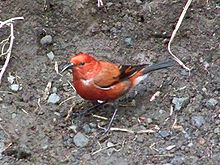
The true finches are small to medium-sized passerine birds in the family Fringillidae. Finches generally have stout conical bills adapted for eating seeds and nuts and often have colourful plumage. They occupy a great range of habitats where they are usually resident and do not migrate. They have a worldwide native distribution except for Australia and the polar regions. The family Fringillidae contains more than two hundred species divided into fifty genera. It includes the canaries, siskins, redpolls, serins, grosbeaks and euphonias, as well as the morphologically divergent Hawaiian honeycreepers.

The Laysan finch is a species of Hawaiian honeycreeper, that is endemic to the Northwestern Hawaiian Islands. It is one of four remaining finch-billed Hawaiian honeycreepers and is closely related to the smaller Nihoa finch. The Laysan finch is named for Laysan, the island to which it was endemic on its discovery. It was subsequently introduced to a few other atolls, and its historical range included some of the main islands.
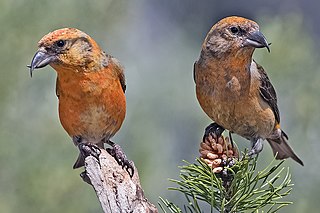
The cardueline finches are a subfamily, Carduelinae, one of three subfamilies of the finch family Fringillidae, the others being the Fringillinae and the Euphoniinae. The Hawaiian honeycreepers are now included in this subfamily. Except for the Hawaiian honeycreepers which underwent adaptive radiation in Hawaii and have evolved a broad range of diets, cardueline finches are specialised seed eaters, and unlike most passerine birds, they feed their young mostly on seeds, which are regurgitated. Besides this, they differ from the other finches in some minor details of their skull. They are adept at opening seeds and clinging to stems, unlike other granivorous birds, such as sparrows and buntings, which feed mostly on fallen seeds. Some members of this subfamily are further specialised to feed on a particular type of seed, such as cones in the case of crossbills. Carduelines forage in flocks throughout the year, rather than keeping territories, and males defend their females rather than a territory or nest.

Drepanis is a genus of Hawaiian honeycreeper in the subfamily Carduelinae of the family Fringillidae.
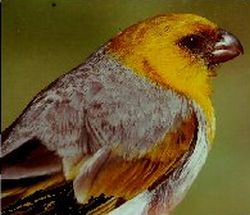
Loxioides is a genus of Hawaiian honeycreeper, in the subfamily Carduelinae.

Akialoa is an extinct genus of Hawaiian honeycreeper in the subfamily Carduelinae of the family Fringillidae. The ʻakialoa species are all extinct, but they formerly occurred throughout Hawaii.

The Maui Nui ʻakialoa or Lānaʻi ʻakialoa is an extinct species of Hawaiian honeycreeper in the subfamily Carduelinae of the family Fringillidae. It inhabited the islands of Maui, Lānaʻi, and Molokaʻi in Hawaii.

Chloridops is an extinct genus of Hawaiian honeycreeper in the subfamily Carduelinae of the family Fringillidae.

The Oʻahu ʻamakihi is a species of Hawaiian honeycreeper in the family Fringillidae. The male is rich yellow below, sharply contrasted with greenish upper parts. Females are duller and have two prominent wing-bars. It has a total length of approximately 4.5 inches (11 cm). It is endemic to the island of Oʻahu in Hawaiʻi, and is likely the only surviving honeycreeper endemic to the island.

Hemignathus is a genus of Hawaiian honeycreepers in the subfamily Carduelinae of the family Fringillidae. All species are endemic to Hawaii.

The ʻapapane is a small, crimson species of Hawaiian honeycreeper endemic to the Hawaiian Islands. They are the most abundant and widely distributed honeycreeper and are found on the islands of Hawaiʻi, Maui, Lānaʻi, Kauaʻi, Molokaʻi and Oʻahu.

Paroreomyza is a genus of Hawaiian honeycreeper in the subfamily Carduelinae of the family Fringillidae. These birds are endemic to Hawaii.

Rhodacanthis, commonly known as the koa finches, is an extinct genus of Hawaiian honeycreeper in the subfamily Carduelinae of the family Fringillidae. All four species were endemic to Hawaii.
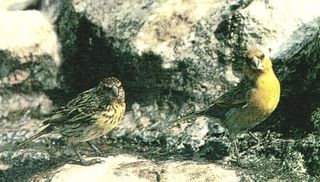
Telespiza is a genus of Hawaiian honeycreeper. All species in it are or were endemic to the Hawaiian Islands.
The primitive koa finch is an extinct species of Hawaiian honeycreeper in the subfamily Carduelinae of the family Fringillidae. It is known from fossils on the islands of Maui and Oʻahu in Hawaii.
The hoopoe-billed ʻakialoa is an extinct species of Hawaiian honeycreeper in the subfamily Carduelinae of the family Fringillidae. It inhabited the islands of Kauaʻi and Oʻahu in Hawaii.

The Laysan honeycreeper or Laysan ʻapapane is an extinct bird species that was endemic to the island of Laysan in the Northwestern Hawaiian Islands.
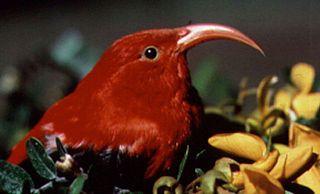
Hawaiian honeycreepers are a group of small birds endemic to Hawaiʻi. They are members of the finch family Fringillidae, closely related to the rosefinches (Carpodacus), but many species have evolved features unlike those present in any other finch. Their great morphological diversity is the result of adaptive radiation in an insular environment. Many have been driven to extinction since the first humans arrived in Hawaii, with extinctions increasing over the last 2 centuries following European discovery of the islands, with habitat destruction and especially invasive species being the main causes.

Chlorodrepanis is a genus of Hawaiian honeycreeper in the subfamily Carduelinae of the family Fringillidae.
